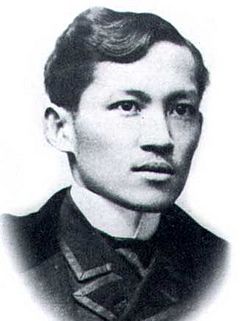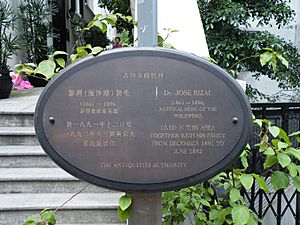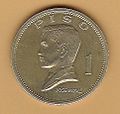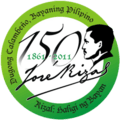Jose Rizal facts for kids
Quick facts for kids
Jose Rizal
|
|
|---|---|
 |
|
| Born |
José Protasio Rizal Mercado y Alonso Realonda
June 19, 1861 |
| Died | December 30, 1896 (aged 35) |
| Cause of death | Execution by firing squad |
| Monuments | Luneta Park, Manila, Calamba, Laguna, Daet, Camarines Norte, Carson, California |
| Other names | Pepe, Jose (nicknames) |
| Alma mater | Ateneo Municipal de Manila University of Santo Tomas Universidad Central de Madrid |
| Organization | La Solidaridad, La Liga Filipina |
| Spouse(s) | Josephine Bracken (1896) |
| Parent(s) | Francisco Mercado Rizal (father) Teodora Alonso Realonda (mother) |
| Signature | |
José Protasio Rizal Mercado y Alonso Realonda, known to many as José Rizal (born June 19, 1861 – died December 30, 1896), was a very important Filipino hero. He lived during the time when Spain ruled the Philippines. Rizal was a true polymath, meaning he was good at many different things, like writing, art, and science.
He was an eye doctor by profession. But he also became a writer and a main member of the Propaganda Movement. This group worked to bring about changes for the Philippines under Spanish rule.
The Spanish government executed him because they believed he was involved in the Philippine Revolution. This revolution, a fight for freedom, was partly inspired by his powerful writings. Even though he wasn't directly involved in planning the revolution, he agreed with its goals. His actions and writings helped lead to Philippine independence.
Today, José Rizal is seen as one of the greatest heroes of the Philippines. Many people believe he should be officially named a national hero. He wrote many poems and essays that are still studied today.
Contents
Rizal's Family and Early Life
José Rizal was the seventh of 11 children in his family. He had two brothers and nine sisters. His parents were well-educated and respected. His father, Francisco Rizal Mercado, was a hardworking farmer from Biñan, Laguna. Rizal looked up to him a lot.
His mother, Teodora Alonso Realonda y Quintos, was born in Meisic, Sta. Cruz, Manila. She loved to read and knew a lot about art and other subjects. Rizal described her as loving and very smart. He learned the alphabet from his mother when he was just three years old. By age five, while learning to read and write, he also showed a talent for drawing and painting. He surprised his family with his pencil drawings, sketches, and clay moldings.
Rizal's Education and Learning
In 1877, when he was 16, Rizal finished his studies and earned a Bachelor of Arts degree from the Ateneo Municipal de Manila. In the same year, he started studying Philosophy and Letters at the University of Santo Tomas. At the same time, he also took classes at Ateneo to become a surveyor and assessor.
In 1878, he began studying to become a doctor at the University of Santo Tomas. However, he stopped his studies there because he felt that Filipino students were not being treated fairly by the priests who taught them.
On May 3, 1882, Rizal traveled by boat to Spain. There, he continued his education at the Universidad Central de Madrid. On June 21, 1884, at 23 years old, he earned his degree and became a doctor. A year later, on June 19, 1885, he received another degree in Philosophy and Letters. Rizal was very smart and traveled a lot throughout Europe, America, and Asia. He could speak 22 different languages!
Rizal's Later Life and Death
When the Philippine Revolution began on August 26, 1896, Rizal's enemies quickly targeted him. They found people to speak against him and tried to connect him to the war. Rizal was never allowed to face these people in court. Because the Spanish leaders believed he was responsible for the actions of the rebels, he was sent away to the city of Dapitan in Zamboanga, in the Southern Philippines.
From November 3, 1896, until his death, he was held in prison at Fort Santiago. During his last days in prison, he wrote a famous poem called Mi Ultimo Adios (My Last Farewell). This poem shares Rizal's final thoughts and goodbyes.
After a trial by the military, he was found guilty of going against the government and causing trouble. He was sentenced to death. José Rizal was executed by a firing squad early in the morning of December 30, 1896, at Bagumbayan Field. His body was first buried in an unmarked grave. Later, his bones were moved to their final resting place at the Rizal Monument, where they are honored today.
Images for kids
-
Rizal's house in Calamba, Laguna.
-
Rizal at 11 years old, a student at the Ateneo Municipal de Manila.
-
Rizal as a student at the University of Santo Tomas.
-
Leaders of the reform movement in Spain. From left to right: Rizal, del Pilar, and Ponce (c. 1890).
-
A photo of Rizal's execution in what was then Bagumbayan.
-
Rizal on the front side of a 1970 Philippine peso coin.
-
The Portrait of Rizal, a painting by Juan Luna.
See also
 In Spanish: José Rizal para niños
In Spanish: José Rizal para niños






























